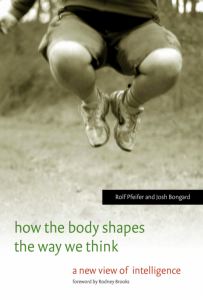 Zusammenfassungen
Zusammenfassungen
 This book explores embodied intelligence and its implications points toward a theory of intelligence in general; with case studies of intelligent systems in ubiquitous computing, business and management, human memory, and robotics. How could the body influence our thinking when it seems obvious that the brain controls the body? In "How the Body Shapes the Way We Think", Rolf Pfeifer and Josh Bongard demonstrate that thought is not independent of the body but is tightly constrained, and at the same time enabled, by it. They argue that the kinds of thoughts we are capable of have their foundation in our embodiment - in our morphology and the material properties of our bodies. This crucial notion of embodiment underlies fundamental changes in the field of artificial intelligence over the past two decades, and Pfeifer and Bongard use the basic methodology of artificial intelligence - "understanding by building" - to describe their insights. If we understand how to design and build intelligent systems, they reason, we will better understand intelligence in general. In accessible, nontechnical language, and using many examples, they introduce the basic concepts by building on recent developments in robotics, biology, neuroscience, and psychology to outline a possible theory of intelligence. They illustrate applications of such a theory in ubiquitous computing, business and management, and the psychology of human memory. Embodied intelligence, as described by Pfeifer and Bongard, has important implications for our understanding of both natural and artificial intelligence.
This book explores embodied intelligence and its implications points toward a theory of intelligence in general; with case studies of intelligent systems in ubiquitous computing, business and management, human memory, and robotics. How could the body influence our thinking when it seems obvious that the brain controls the body? In "How the Body Shapes the Way We Think", Rolf Pfeifer and Josh Bongard demonstrate that thought is not independent of the body but is tightly constrained, and at the same time enabled, by it. They argue that the kinds of thoughts we are capable of have their foundation in our embodiment - in our morphology and the material properties of our bodies. This crucial notion of embodiment underlies fundamental changes in the field of artificial intelligence over the past two decades, and Pfeifer and Bongard use the basic methodology of artificial intelligence - "understanding by building" - to describe their insights. If we understand how to design and build intelligent systems, they reason, we will better understand intelligence in general. In accessible, nontechnical language, and using many examples, they introduce the basic concepts by building on recent developments in robotics, biology, neuroscience, and psychology to outline a possible theory of intelligence. They illustrate applications of such a theory in ubiquitous computing, business and management, and the psychology of human memory. Embodied intelligence, as described by Pfeifer and Bongard, has important implications for our understanding of both natural and artificial intelligence. Dieses Buch erwähnt ...
Dieses Buch erwähnt ...
 Personen KB IB clear | Ross Ashby , Valentin Braitenberg , Cynthia L. Breazeal , Rodney Brooks , Clayton Christensen , Mihaly Csikszentmihalyi , Charles Darwin , Richard Dawkins , Peter Drucker , Paul Ekman , Fernando Flores , James Gleick , Donald Hebb , Cinda Heeren , Mark Johnson , Stanley Kubrick , Ray Kurzweil , G. Lakoff , Warren McCulloch , Charlie Meyer , Marvin Minsky , John von Neumann , Alan Newell , Rolf Pfeifer , Jean Piaget , Steven Pinker , Walter Pitts , Karl R. Popper , Christian Scheier , Eric Shaffer , Jon Tedesco , Alan Turing , Mark Weiser , Joseph Weizenbaum , Norbert Wiener , Terry Winograd | ||||||||||||||||||||||||||||||||||||||||||||||||||||||||||||||||||||||||||||||||||||||||||||||||||||||||||||||||||||||||||||||||||||||||||||||||||||||||||||||||||||||||||||||||||||||||||||||||||||||||||||||||||||||||||||||||||||||||||||||||||||||||||||
 Begriffe KB IB clear |  Aibo
, Braitenberg VehiclesBraitenberg Vehicles
, EmbodimentEmbodiment
, Aibo
, Braitenberg VehiclesBraitenberg Vehicles
, EmbodimentEmbodiment
,  Intelligenz Intelligenz intelligence
, intelligence
,  Künstliche Intelligenz (KI / AI) Künstliche Intelligenz (KI / AI) artificial intelligence
, Leib-Seele-Problem
, artificial intelligence
, Leib-Seele-Problem
,  machine learning
, Pheromone
, survival of the fittestsurvival of the fittest
, symbolische künstliche Intelligenz (GOFAI) machine learning
, Pheromone
, survival of the fittestsurvival of the fittest
, symbolische künstliche Intelligenz (GOFAI)
| ||||||||||||||||||||||||||||||||||||||||||||||||||||||||||||||||||||||||||||||||||||||||||||||||||||||||||||||||||||||||||||||||||||||||||||||||||||||||||||||||||||||||||||||||||||||||||||||||||||||||||||||||||||||||||||||||||||||||||||||||||||||||||||
 Bücher |
| ||||||||||||||||||||||||||||||||||||||||||||||||||||||||||||||||||||||||||||||||||||||||||||||||||||||||||||||||||||||||||||||||||||||||||||||||||||||||||||||||||||||||||||||||||||||||||||||||||||||||||||||||||||||||||||||||||||||||||||||||||||||||||||
 Texte |
|
 Tagcloud
Tagcloud
 Zitationsgraph
Zitationsgraph
 Zitationsgraph (Beta-Test mit vis.js)
Zitationsgraph (Beta-Test mit vis.js)
 Zeitleiste
Zeitleiste
 3 Erwähnungen
3 Erwähnungen 
- Werkspuren 1/2012 - Robotik (2012)

- Künstliche Intelligenz, Erziehungswissenschaft und Neurodidaktik (Thomas Emmenegger)

- Künstliche Intelligenz, Erziehungswissenschaft und Neurodidaktik (Thomas Emmenegger)
- EmbedIT - an Open Robotic Kit for Education (Dorit Assaf) (2013)


- Mehr als 0 und 1 - Schule in einer digitalisierten Welt (Beat Döbeli Honegger) (2016)


- 6. Wozu Informatik? (2016)

- 6. Wozu Informatik? (2016)
 Volltext dieses Dokuments
Volltext dieses Dokuments
 Bibliographisches
Bibliographisches 
 Beat und dieses Buch
Beat und dieses Buch
Beat war Co-Leiter des ICT-Kompetenzzentrums TOP während er dieses Buch ins Biblionetz aufgenommen hat. Die bisher letzte Bearbeitung erfolgte während seiner Zeit am Institut für Medien und Schule. Beat besitzt kein physisches, aber ein digitales Exemplar. (das er aber aus Urheberrechtsgründen nicht einfach weitergeben darf). Es gibt bisher nur wenige Objekte im Biblionetz, die dieses Werk zitieren.








 (
(




 , 6114 kByte)
, 6114 kByte) 



 Biblionetz-History
Biblionetz-History